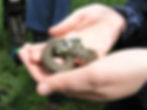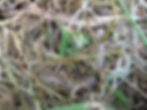



There are six native species of reptile in England. Our native lizards are the common lizard, the slow-worm and the sand lizard. Our native snakes are the adder , the smooth snake and the grass snake.
Reptiles are ectothermic; they are unable to produce or regulate their own body heat internally and rely on behavioural mechanisms (i.e. basking) to regulate their body temperature using external heat sources. Reptile activity and behaviour is thus heavily influenced by the weather. In general, the inactive season is between October and March. Even during the active season, between April and September, levels of activity are weather dependent.
Reptiles tend to occur in areas of free-draining soil. They are found in a variety of habitats, including rough grassland, scrub and woodland edges, and man-made areas such as road and railway embankments, brownfield sites and gardens. In general, the requirements are a habitat ‘mosaic’, offering areas in which to bask, to seek refuge and to forage (mainly for invertebrates, although grass snakes tend to take amphibians whilst adders and smooth snakes largely eat other reptiles and small mammals).
Ecology
Surveys
Presence/Absence and Population Size
Reptile surveys are undertaken using squares of thin material, usually 1 square metre in area, which are laid on the ground in locations where reptiles will be able to lie underneath, basking in safety under the material which accentuates the heat of the sun.
Refugia – features under which they can bask but remain hidden - are of great value to reptiles. Reptile surveys manipulate this requirement by using roofing felt or thin sheets of corrugated tin;
After allowing the artificial refugia to ‘bed in’ for up to two weeks, a minimum of seven reptile surveys should be undertaken.
During these surveys the surveyor quietly approaches the refuge, checking its upper surface for basking reptiles, and then lifts the refuge to check for reptiles underneath.
All surveys should be carried out during optimum atmospheric conditions in which to find reptiles when they are basking:
-
the air temperature between 9 and 18 °C
-
humid sunny spells through overcast cloud (as opposed to bright sunshine) if temperatures are high
-
little wind
-
no rain
Reptile surveys are usually undertaken either between 8:30 am and 11:00 am or 4:00 pm and 6:30 pm; periods when reptiles are sluggish either prior to, or some time following, high levels of solar irradiation.
Reptiles
Legislation
All common species of reptile are protected under Schedule 5 of the Wildlife & Countryside Act 1981. Species such as the adder, grass snake, common lizard and slow-worm are listed in respect to Section 9 (1) & (5). For these species, it is prohibited to:
-
Intentionally (or recklessly) kill or injure these species
-
Sell, offer or expose for sale, possess or transport for purpose of sale these species, or any part thereof.
The penalty for the above listed offences can be a fine up to level 5 (£5,000) on the standard scale per offence, and/or a prison sentence of up to six months. Harm to more than one animal may be taken as separate offences, and the police may confiscate any equipment used to commit the offence.
Sand lizards and smooth snakes are afforded more protection from both the Wildlife and Countryside Act 1981 and the Conservation of Habitats & Species Regulations 2010;
Mitigation & Compensation
If reptiles are present on site and would be affected by the proposed activity, steps should be taken to prevent killing or injuring the population and individual animals.
This may be achieved by habitat manipulation and hand searches in some cases. Often it is necessary to move the reptiles to an appropriate 'receptor' site. This involves installing reptile fencing and capturing any reptiles found under artificial refugia placed out to attract them.
The process of capturing and translocating reptiles can take a substantial amount of time; the exact number of days it will take to clear a site depends on the population size and area and can be difficult to predict exactly. Therefore it is essential that this activity is planned as early as possible in the development process.
